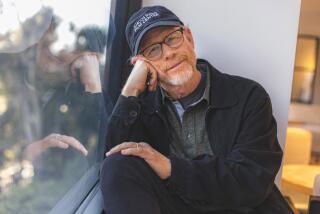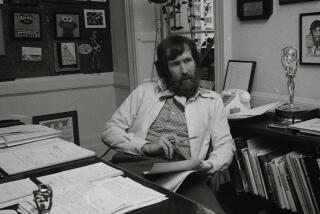In a CGI-dominated world, Netflix’s ‘The Dark Crystal: Age of Resistance’ chooses puppets over pixels
Brian Froud, the primary concept artist and costumer on both the 1982 film “The Dark Crystal” and Netflix’s upcoming prequel series, “The Dark Crystal: Age of Resistance,” remembers constant trickery on the set of the original.
“Because it’s puppetry, a lot of what we do is disguise,” Froud said. “So a lot of my costuming and designs of characters were in shapes and forms to hide the puppeteers.”
“I know that when I was designing — specifically the Skeksis — Jim Henson and Frank Oz loved them, so they were just encouraging me to make them worse!” he added, referring to the villainous, vulture-like creatures who subjugate, and help to corrode, much of the world of Thra.
Worse, and more frightening. Fear of the Skeksis is a common reaction to the original “Dark Crystal.” The initial feedback surprised Froud and the others, since they “didn’t even think about whether it was for children or adults.” But he knows the world has changed.
“Now we’re living in a generation that has gone through so many iterations of fantasy films that have a darker side that I think ‘The Dark Crystal’s’ time has really come again.”
The Netflix series, which premieres Friday, is a prequel to the film, a way to see the magical world of Thra before it’s ruined by the Skeksis and their greed. That world is still filled with creatures like the peaceful, heroic, elf-like Gelflings; the gardening, dirt-loving Podlings; and the dog-like balls of rolling fur called Fizzgig. Like the “Star Wars” prequels, viewers will recognize Thra, but it’s shinier.
The influence of the original film’s hair-raising puppets was felt strongly by a young Louis Leterrier back in the 1980s. Now the director of the series, Leterrier said it wasn’t only the story, but also the process, that drew him in.
“It was a very visceral, intense experience, because I was 10, I think, and I started making short films using my toys and stuff — Super 8 movies — and this felt like it was the mega version of what [I was] doing,” he said in a telephone interview.
“It completely changed the course of my life.”
That might seem like hyperbole until you hear Leterrier talk about how, after a successful run of films that included the “Transporter” franchise, “The Incredible Hulk” and “Clash of the Titans,” the only movie-industry people he wanted to meet with were the folks at the Jim Henson Co.
“[Louis] asked for a meeting in 2011, and when [he] said he was interested in making the film, we were already starting to remake it,” said “Age of Resistance” executive producer Lisa Henson, daughter of Jim and CEO and president of the Jim Henson Co.
Even when Netflix came into the picture and it was clear they wouldn’t be making a film, Leterrier stayed on.
“He said yes just because of the opportunity to make even more.”
Keeping ‘Crystal’ in the family
Chatting at Netflix’s Hollywood offices, Henson recounted that she was in college when the “Dark Crystal” was in production. She and her siblings grew up on sets and often helped out, so it was with a bit of nostalgia that she helped guide the new production, making sure it stayed true to the original’s tone.
That meant using puppets. In an era of computer-generated images, both Henson and Leterrier were adamant about keeping the series as tactile as possible. Both say that, despite the use of CGI for backgrounds, puppeteer removal and the occasional enhancement, 95% of the production was shot on real-life sets with actual puppets.
“Maybe even 98%? I knew going into this one, it had to look like the original movie. It had to feel like the original movie,” Leterrier said.
“It’s practical and almost obsolete in its technique. But you feel it,” the director continued. “It’s hard to explain the human brain playing tricks on you and accepting a truth that clearly isn’t.”

In Netflix’ “The Dark Crystal: Age of Resistance,” Deet (Nathalie Emmanuel), Rian (Taron Edgerton) and Brea (Anya Taylor Joy) are on a quest to find hope in darkness, save Thra, and reveal their destiny.
“They have such subtlety, and the performances have such nuance that is very surprising even to me, as I’ve grown up with puppets my whole life,” said Henson.
She also emphasized that the best way to keep all the emotions that puppetry — specifically “The Dark Crystal” — once gave audiences was to bring back Froud to help re-create the mood.
“It’s so textured and symbolic,” Froud said. “And it’s all made out of stuff, made out of real things, and that brings a great deal of life to it. It’s not just made out of pixels. Whatever pixels are.”
Epic CGI could have caused the budget to soar on a 10-episode series, but Netflix, known for being tight-lipped yet spending freely, greenlighted the project when there was very little to get behind, story-wise. As Henson and Leterrier developed the 2011 film, they were constantly drawn back to the past. So they scrapped the sequel movie idea — which eventually became a graphic novel — and began planning the prequel before the Netflix deal was made.
“The money they put up up front was enormous compared to literally any movie I’ve done before. I mean, we had to create everything. Not only your cast, but your sets, your world ... That’s when I felt like I needed to commit to every episode,” Leterrier said.
Technically speaking, the puppets are not light years ahead of what they were in 1982, Froud said. The animatronics have advanced along with the filmmaking world and, according to Henson, the puppets themselves are larger than before. But Froud still saw the CGI process, and the fact that many of the handlers wore green-screen suits to be digitally removed later, as something that could help puppeteers reconnect to a niche art.
“We can go back to doing the Bunraku puppeteering,” said Froud, referring to the Japanese method of puppeteering in which the handlers are visible.
“The Japanese puppeteers are dressed in black and they are on the outside of the puppet to manipulate the puppet. So you see the puppeteer, but you eliminate them in your mind.”
Henson and Leterrier also wanted to make sure there were distinctive voices to match the arresting images. They put out the call, and it was answered in impressive fashion by Helena Bonham-Carter, Alicia Vikander, Keegan-Michael Key and others.
“We went big with the voices. Harvey Fierstein does not sound like Jason Isaacs. Neither of them sounds like Mark Hamill. Awkwafina!” said Henson. “Big personalities, big characters.”
Two actors in Thra
“It’s fun in a mystical kind of way that I think a lot of people have forgotten about,” said Anya Taylor-Joy, who voices the rebellious Gelfling princess Brea.
The busy 23-year-old, reached in a car while being whisked through London, has three films coming out next year but threw herself into “The Dark Crystal” because she’s a huge fan of the original.
“It is so cool! I was just like ‘... yeah I want to be a giant puppet!’ With huge braids and eyes that don’t look as far apart as mine do in day-to-day life. [The puppet’s eyes] just look normal. I want that for my life.”
Taking a break from filming “Fast & Furious 9” in London, Taylor-Joy’s “Crystal” cast mate Nathalie Emmanuel, like Leterrier, remembers being freaked out by the film. (Something of a sci-fi/fantasy fan as a kid, she also recalled “The Neverending Story” as a favorite.) Having just finished “Game of Thrones,” a franchise with an ardent following of its own, she understands the pressures that come with taking on properties with a built-in fandom.
“I try not to think about that too much, ’cause it puts a lot of pressure on us,” Emmanuel said. “Everyone’s going to have their opinions about all of that, and I think it’s kind of cool that people take this thing that they loved as a kid and say, ‘What would happen if we expanded the world further or told this specific story?’”
Both Emmanuel and Taylor-Joy had to learn on the fly about voicing puppets, and the symbiotic relationship actors have with puppeteers who are not in the room. One lesson was speaking their lines to match the puppeteers’ cadence.
“I was very lucky that my wonderful puppeteer Alice [Dinnean], who is one of the best in the [business], was truly amazing. There were definitely some moments where I wanted to do it a certain way, but Alice had already done it, so I had to fit it into her [way of speaking],” Taylor-Joy said.
“Essentially, you just have to do the line like the line, and try to get the words and the mouth movements. Beccy [Henderson] has a different accent than me, she’s from Northern Ireland, so she has a different way of speaking with, like, speed and cadence and all of that,” said Emmanuel.
“It was one of the most challenging things I’ve ever had to do.”
A ‘Dark’ legacy
The other main actor in the series, Taron Egerton, is also a fan of the franchise, and according to Henson may have created a “snowball effect” for the other actors to get involved.
“Taron Egerton said yes just reading the title of the email. ‘“Dark Crystal” voice? Yes!’” Leterrier said. “Two years ago. He didn’t even know if the script was any good.”
“On the Skeksis side, Andy Samberg came along early, and that created a snowball among the Skeksis characters,” said Henson.
The film’s popularity also underscores a point Henson made emphatically: Though some confuse “Crystal” for a cult success because so many have seen and been affected by it long after its theatrical run, that’s not entirely true.
“I think they think it’s ‘Labyrinth,’ but it’s not,” Henson said. “‘The Dark Crystal’ was a very successful movie. And will make a great series.”
“It’s an ode to Jim Henson and the other puppeteers,” Leterrier said. “Picking up the torch for the greatest puppet movie ever made and saying ... ‘Let’s continue down that path. Let’s use the same techniques.’”
More to Read
The complete guide to home viewing
Get Screen Gab for everything about the TV shows and streaming movies everyone’s talking about.
You may occasionally receive promotional content from the Los Angeles Times.







